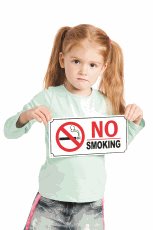Secondhand Smoke Increases Risk of Ear Infection in Children
 Secondhand smoke is the combination of smoke produced by burning tobacco products and smoke that is exhaled by smokers. It contains hundreds of toxic chemicals, including at least 70 with known connections to cancer. No amount of secondhand smoke is safe – even short-term exposure poses a health risk. It is estimated that more than 50,000 nonsmokers die each year due to health problems resulting from exposure to secondhand smoke.
Secondhand smoke is the combination of smoke produced by burning tobacco products and smoke that is exhaled by smokers. It contains hundreds of toxic chemicals, including at least 70 with known connections to cancer. No amount of secondhand smoke is safe – even short-term exposure poses a health risk. It is estimated that more than 50,000 nonsmokers die each year due to health problems resulting from exposure to secondhand smoke.
Secondhand smoke poses a significant threat to fetuses, infants, and children, as it can damage developing organs such as the lungs and brain. Among children, exposure to secondhand smoke has been linked to ear infections, asthma, respiratory infections such as bronchitis and pneumonia, and sudden infant death syndrome (SIDS).
Exposure to secondhand smoke has been shown to increase both the frequency and duration of ear infections among children. Such exposure causes swelling that interferes with pressure equalization in the ear, leading to pain, fluid buildup, and infection. Ear infections are the leading cause of hearing loss among children, and severe infections may require the surgical insertion of tubes into the child’s ear. Accounting for nearly 800,000 physician office visits each year, American children receive more medical treatment for ear infections than for any other condition.
In 2006, the American Surgeon General issued a startling report that outlined the negative impact that secondhand smoke has on the nation’s children. Children may face a greater risk from secondhand smoke than adults because their young bodies are still growing, and the poisonous chemicals in secondhand smoke may affect their development.
The American Surgeon General’s report stated unequivocally that secondhand smoke causes premature death and disease in children and adults who do not smoke and that children who are exposed to secondhand smoke are at increased risk for acute respiratory infections, ear problems, more severe asthma sudden infant death syndrome (SIDS). Meanwhile, the American Lung Association reports that secondhand smoke results in 7,500 to 15,000 hospitalizations and 430 SIDS deaths in the U.S. each year.
Even as awareness of secondhand smoke increases, many children continue to be exposed to secondhand smoke on a regular basis. Between 2011 and 2012, approximately 40 percent of children ages 3 to 11 in the United States, including about 70 percent of African-American children, were regularly exposed to secondhand smoke.
Separating smokers from nonsmokers, opening windows, and using air filters are ineffective methods of limiting exposure to secondhand smoke. Instead, parents should ensure that their homes and vehicles are smoke-free, as well as their child’s daycare center or school. Avoid public places that allow smoking, and teach children to avoid secondhand smoke at all times. Smokers should begin taking steps to quit smoking immediately.
The Quit for Your Health tobacco cessation program at LMHS is designed to help people stop using tobacco. Our counselors utilize evidence-based techniques to help participants develop a plan to become tobacco-free. LMHS also offers the Quit for You, Quit for Your Baby program for expectant and postpartum mothers. Upon successful completion of the 34-week program, participants receive a $50 gift card to select businesses.
For more information about either tobacco cessation program or to schedule an appointment, please call (220) 564-QUIT (7848). Both programs are offered at no cost to the community.
| Posted On : 10/8/2015 1:48:38 PM
Filed under: